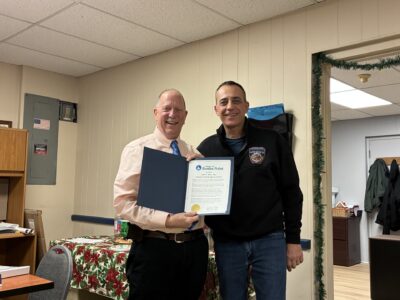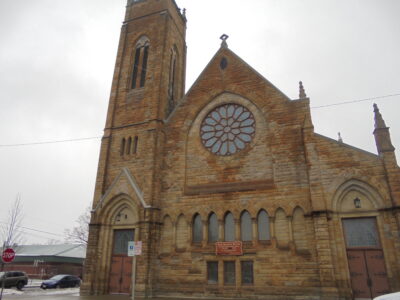Thruway Director Talks E-ZPass, Rest Stop Improvements
New Yorkers are being asked to get their E-ZPass to travel the New York State Thruway — and can possibly look forward to newer rest areas in the years ahead.
Matthew Driscoll, state Thruway Authority executive director, testified recently before a joint legislative budget committee on the proposed budget for the state Transportation Department. Driscoll was asked by Sen. Tim Kennedy, D-Cheektowaga and chair of the Senate Transportation Committee, what the Thruway Authority is doing to make sure that E-ZPass is accessible to everyone. The question was prompted by the Thruway Authority’s decision earlier this year to change Thruway toll rates.
The standard E-ZPass toll rate will become the base toll rate. Rates will be 30% higher for tolls paid by mail with an additional $2 administrative surcharge per billing statement for those who don’t have an E-ZPass. Out-of-state E-ZPass drivers on the Thruway will pay 15% more than state residents. Thruway officials defended the 30% higher rate for those who don’t use E-ZPass earlier this year by comparing the state’s higher rates to other states. Massachusetts has an 87% differential on the Massachusetts Turnpike and 109% on the Boston Extension. The Miami-Dade Expressway has a 100% differential and the Pennsylvania Turnpike charges a 36% differential.
Driscoll testified cashless tolling went active Nov. 14, six weeks ahead of schedule. Driscoll said cashless tolling is a long-term capital investment that improves the safety and convenience of the system for customers, has already reduced congestion and improved traffic flow with the reduction of stop and go traffic and idling at toll plazas. Six toll plazas at six high volume interchanges have been removed, so 50% of all traffic no longer passes through a toll booth.
Along with the conversion to system-wide cashless tolling, the Thruway Authority has expanded its aggressive education and marketing campaign to raise awareness and promote E-ZPass usage — the most convenient way to pay for tolls.
This is a multi-platform campaign including social media, drive-time radio ads and targeted in-app advertisements on Waze and search engines.
“Again, we are urging everyone to get an E-ZPass,” Driscoll said. “It really is the most efficient way to pay your tolls. It avoids a toll by mail process, which means we have to mail you a bill. That’s expensive for us. There’s a reason we call it cashless tolling. We don’t want to accept cash any longer. We want to do everything electronically as other toll roads across the United States do as well. We’ll continue marketing strongly on that. We’ve seen a real uptick in usage of E-ZPass across the state. It exceeds 87% upstate, about 80% statewide. So we’re making good progress. We have given away over 100,000 transponders since we ignited this marketing push program just a short while ago, so we’re going to stay at it. Look, like anything, it’s always about education, reinforcing that education.”
State Sen. Jim Tedisco, R-Glenville, has introduced the Thruway Toll Equity Act in the state Senate to roll back the 30% increase in Thruway tolls and the $2 billing surcharge for any New Yorker who lives below the federal poverty line and who doesn’t have an E-ZPass. Kennedy has introduced his own legislation, S.1746, to waive the deposit required when purchasing a new E-ZPass for 60 days while stipulating that any retail location that sells E-ZPass must also accept cash payments to reload an E-ZPass tag.
“For someone to be able to walk into a gas station and actually acquire an E-ZPass but they can’t go into that same gas station and actually load it or reload it with cash, therein lies the problem especially for lower income or underbanked communities,” Kennedy said during the hearing. “We’re hopeful to work with you to get this legislation or an iteration of it passed to expand the accessibility for that E-ZPass.”
Assemblywoman Deborah Glick, D-New York City, asked Driscoll about plans to refurbish rest stop plazas on the Thruway after noticing other states have nicer rest stops than New York does.
“Before the world came to sort of a crashing halt I had the opportunity to do a little travel down to Virginia and down to the Jersey Shore,” Glick said. “In both instances I have to say the rest stops in other places are more appealing and more customer-friendly and I’m just wondering whether we have long-term contracts that limit what can be done at our rest stops and whether there’s a future where we’ll have better, more welcoming rest stops?”
Driscoll testified that rebuilding and redevelopment of the Thruway’s 27 service areas is advancing. The selected proposer, Empire State Thruway Partners, was approved by the Thruway Authority board in May 2020 with a $450 million investment plan. Service area improvements include enhancing customer amenities, technology, commercial truck services and overall facility energy efficiency, including electric vehicle charging stations. The Thruway Authority also plans to create a network of electric vehicle charging stations. There are now 39 electric vehicle charging stations at 23 locations on the Thruway system. Eventually, Driscoll expects to have 100 fast- charging electric vehicle stations with an average of 30 miles between each location along the Thruway as part of the rest area investment plan.
“I would agree that our Thruway service areas need an upgrade,” Driscoll said. “That’s the reason why last year our board of directors approved us moving forward with Empire Partners, who is going to renovate, and frankly, rebuild, the 27 service plazas throughout New York state on our system. We’re excited about that because that’s really going to bring a tremendous upgrade for, again, our customers because our customers are how we maintain and operate and pay the bills at the Thruway Authority. We want to have the most modern, convenient facilities that we can. These are going to include upgrades for the truckers who, the freight economy is a big part of our business model. It’s going to include TasteNY. We’re going to want to make sure that we are helping to promote the local agribusiness and artisans that are in these regions. And it’s going to have a strong focus on healthy food choices as well. I think you’re going to be very pleased when you see that all come to fruition.”





